
|
It returns for the first time in 70 years. It will brighten up to 4.5 mag in spring. It suddenly brightened in major outburst by 5 mag up to 11.5 mag on July 20 (E. Tamas, Francois Kugel). It brightened again in another major outburst up to 9.4 mag on Nov. 15 (Nick James). Now it is 7.4 mag (Feb. 19, Virgilio Gonano). Brightening gradually. In the Northern Hemisphere, it will be unobservable in April. In the Southern Hemisphere, it is not observable now, but it will appear in April.
Date(TT) R.A. (2000) Decl. Delta r Elong. m1 Best Time(A, h)
Feb. 24 23 8.16 36 50.6 1.726 1.289 47 7.7 19:14 (124, 17)
Mar. 2 23 43.53 35 30.3 1.685 1.198 44 7.2 19:20 (122, 17)
|
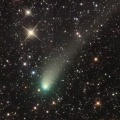
|
Now it is 10.2 mag (Feb. 14, Osamu Miyazaki). Fading gradually. In the Northern Hemisphere, it stays observable in good condition. In the Southern Hemisphere, it will be getting lower gradually after this, and it will be unobservable in May.
Date(TT) R.A. (2000) Decl. Delta r Elong. m1 Best Time(A, h)
Feb. 24 17 53.04 -10 38.4 1.354 1.327 66 9.1 5:12 (315, 32)
Mar. 2 18 13.33 -4 45.7 1.322 1.342 69 9.1 5:04 (311, 37)
|
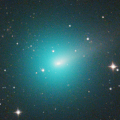
|
It brightened up to 7.4 mag from December to January (Dec. 24, Osamu Miyazaki). Now it is 8.9 mag (Feb. 13, Chris Wyatt). It will fade out rapidly after this. It will be fainter than 18 mag in June. It stays observable in good condition.
Date(TT) R.A. (2000) Decl. Delta r Elong. m1 Best Time(A, h)
Feb. 24 12 40.93 9 57.7 0.523 1.455 146 9.5 2:29 ( 0, 65)
Mar. 2 12 37.07 10 7.0 0.542 1.496 153 9.9 1:58 ( 0, 65)
|

|
Now it is 10.5 mag (Feb. 16, Osamu Miyazaki). It will fade out rapidly after this. It stays observable in good condition.
Date(TT) R.A. (2000) Decl. Delta r Elong. m1 Best Time(A, h)
Feb. 24 5 15.27 17 11.2 0.824 1.439 104 10.2 19:14 ( 9, 72)
Mar. 2 5 36.98 17 27.9 0.874 1.460 102 10.3 19:20 ( 18, 72)
|
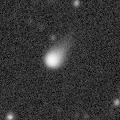
|
It will approach to Sun down to 0.4 a.u. in late September, and it is expected to brighten up to 0 mag. Now it is 12.7 mag (Feb. 15, ATLAS Chile). It will brighten rapidly after this. It stays observable in good condition. At the high light, in the Northern Hemisphere, it will be observable in good condition after the perihelion passage. In the Southern Hemisphere, it will be observable in the low sky before and after the perihelion passage.
Date(TT) R.A. (2000) Decl. Delta r Elong. m1 Best Time(A, h)
Feb. 24 15 8.41 -7 34.1 3.198 3.620 107 12.6 4:56 ( 0, 47)
Mar. 2 15 5.29 -7 18.0 2.997 3.535 115 12.4 4:26 ( 0, 48)
|
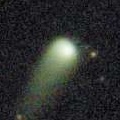
|
Now it is 12.1 mag (Feb. 16, Osamu Miyazaki). It stays 13 mag for a while. In the Northern Hemisphere, it stays observable in good condition. In the Southern Hemisphere, it will be unobservable in June.
Date(TT) R.A. (2000) Decl. Delta r Elong. m1 Best Time(A, h)
Feb. 24 7 41.95 25 1.3 3.295 4.088 138 12.4 21:27 ( 0, 80)
Mar. 2 7 31.39 26 15.0 3.367 4.061 128 12.4 20:49 ( 0, 81)
|

|
First return of a new periodic comet which brightened up to 10 mag in 2001. Now it is 13.1 mag (Feb. 10, Katsumi Yoshimoto). It will fade out rapidly after this. It locates somewhat low in the Northern Hemisphere. In the Southern Hemisphere, it will never be observable after this.
Date(TT) R.A. (2000) Decl. Delta r Elong. m1 Best Time(A, h)
Feb. 24 0 13.24 27 44.0 1.905 1.406 45 12.7 19:14 (108, 24)
Mar. 2 0 25.38 31 49.9 1.922 1.407 44 12.7 19:20 (115, 22)
|

|
Now it is 14.1 mag (Feb. 12, Thomas Lehmann). It stays 13 mag for a while. In the Northern Hemisphere, it will be unobservable in June. In the Southern Hemisphere, it stays observable in good condition. It is expected to brighten up to 12.5 mag in spring. At the high light, it will be observable in excellent condition in the Southern Hemisphere, but it will be low in the Northern Hemisphere.
Date(TT) R.A. (2000) Decl. Delta r Elong. m1 Best Time(A, h)
Feb. 24 14 59.57 -30 41.8 2.300 2.699 102 13.0 4:48 ( 0, 24)
Mar. 2 14 44.90 -32 47.0 2.165 2.695 111 12.9 4:06 ( 0, 22)
|

|
Now it is 13.8 mag (Feb. 12, Hiroshi Abe). It will fade out rapidly after this. It will be fainter than 18 mag in May. It stays observable in good condition. Vladimir Bezugly reported it is visible at around 12 mag in the SOHO LASCO images in late January.
Date(TT) R.A. (2000) Decl. Delta r Elong. m1 Best Time(A, h)
Feb. 24 4 21.94 -16 22.7 0.241 1.003 86 12.9 19:14 ( 19, 37)
Mar. 2 5 32.72 -14 10.3 0.222 1.045 98 12.9 19:20 ( 8, 41)
|

|
It was observed at 9-10 mag for a long time in 2023. Now it is 12.6 mag (Feb. 2, Chris Wyatt). It stays 14 mag for a while. In the Northern Hemisphere, it will never be observable after this. It locates somewhat low in the Southern Hemisphere. But it will become high in spring.
Date(TT) R.A. (2000) Decl. Delta r Elong. m1 Best Time(A, h)
Feb. 24 23 40.96 -39 25.3 4.644 3.863 34 13.2 19:14 ( 55,-19)
Mar. 2 23 45.53 -39 25.8 4.698 3.920 34 13.3 19:20 ( 58,-24)
|
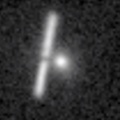
|
It returned for the first time in 68 years. It will brighten up to 7.5 mag in summer. Now it is 13.1 mag (Feb. 14, Alan Hale). It will brighten rapidly after this. In the Northern Hemisphere, it will be getting lower gradually. In the Southern Hemisphere, it will be unobservable in April. At the high light, it locates low in the Northern Hemisphere, or it is not observable in the Southern Hemisphere.
Date(TT) R.A. (2000) Decl. Delta r Elong. m1 Best Time(A, h)
Feb. 24 3 0.52 2 0.4 2.288 2.150 69 13.6 19:14 ( 55, 43)
Mar. 2 3 5.77 4 29.7 2.302 2.076 64 13.3 19:20 ( 64, 39)
|

|
Now it is 14.7 mag (Feb. 13, Chris Wyatt). It stays observable in good condition.
Date(TT) R.A. (2000) Decl. Delta r Elong. m1 Best Time(A, h)
Feb. 24 8 10.11 21 28.5 5.340 6.181 145 13.6 21:55 ( 0, 76)
Mar. 2 8 7.82 21 29.4 5.411 6.183 137 13.6 21:25 ( 0, 76)
|

|
It brightened up to 8 mag from 2022 summer to 2023 spring. Now it is 13.2 mag (Feb. 13, Chris Wyatt). Fading slowly. It will be getting lower gradually after this, and it will be unobservable in May in the Northern Hemisphere, or in June in the Southern Hemisphere.
Date(TT) R.A. (2000) Decl. Delta r Elong. m1 Best Time(A, h)
Feb. 24 5 6.59 5 2.2 4.806 5.087 100 13.6 19:14 ( 11, 60)
Mar. 2 5 6.11 5 58.4 4.979 5.148 94 13.7 19:20 ( 27, 58)
|

|
Now it is 13.9 mag (Feb. 2, Chris Wyatt). Fading slowly. In the Northern Hemisphere, it will be unobservable in May. In the Southern Hemisphere, it stays observable in good condition.
Date(TT) R.A. (2000) Decl. Delta r Elong. m1 Best Time(A, h)
Feb. 24 8 20.23 -44 57.3 4.104 4.656 118 13.9 22:04 ( 0, 10)
Mar. 2 8 8.09 -44 10.4 4.164 4.693 116 14.0 21:24 ( 0, 11)
|

|
Now it is 14.6 mag (Feb. 13, Chris Wyatt). It stays 14 mag for a while. It locates somewhat low in the Northern Hemisphere. In the Southern Hemisphere, it stays observable in good condition.
Date(TT) R.A. (2000) Decl. Delta r Elong. m1 Best Time(A, h)
Feb. 24 12 12.32 -38 45.0 4.574 5.210 125 14.0 2:01 ( 0, 16)
Mar. 2 12 10.42 -38 28.9 4.492 5.194 130 13.9 1:31 ( 0, 16)
|
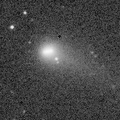
|
Now it is 13.8 mag (Feb. 13, Chris Wyatt). It stays 14 mag for a while. In the Northern Hemisphere, it stays observable in good condition. It stays extremely low in the Southern Hemisphere. But it will become high in winter.
Date(TT) R.A. (2000) Decl. Delta r Elong. m1 Best Time(A, h)
Feb. 24 3 33.41 24 43.9 1.971 2.087 82 13.9 19:14 ( 75, 63)
Mar. 2 3 45.61 25 37.1 2.031 2.073 78 14.0 19:20 ( 82, 60)
|
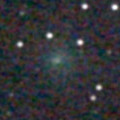
|
It must have brightened up to 11 mag in winter. However, it was too low to observe at the high light. Fading rapidly. It will be fainter than 18 mag in April. It will be getting higher gradually.
Date(TT) R.A. (2000) Decl. Delta r Elong. m1 Best Time(A, h)
Feb. 24 19 46.23 -31 21.5 1.535 1.050 42 14.1 5:12 (309, -1)
Mar. 2 19 33.72 -29 45.3 1.434 1.128 51 14.9 5:04 (312, 5)
|

|
It brightened up to 7.8 mag in late July (July 20, Thomas Lehmann). Now it is 15.8 mag (Feb. 21, Thomas Lehmann). Fading gradually. It stays observable in good condition.
Date(TT) R.A. (2000) Decl. Delta r Elong. m1 Best Time(A, h)
Feb. 24 14 37.71 6 43.1 2.474 3.061 117 14.3 4:26 ( 0, 62)
Mar. 2 14 26.00 8 59.1 2.432 3.131 127 14.4 3:47 ( 0, 64)
|

|
It approached to Earth down to 0.38 a.u., and brightened up to 8.0 mag in autumn (Sept. 29, Virgilio Gonano). Now it is 14.5 mag (Feb. 9, Toshihiko Ikemura, Hirohisa Sato). Fading rapidly. It will be fainter than 18 mag in May. It stays observable in good condition.
Date(TT) R.A. (2000) Decl. Delta r Elong. m1 Best Time(A, h)
Feb. 24 7 59.62 -4 26.7 1.109 1.978 140 14.4 21:45 ( 0, 51)
Mar. 2 7 59.85 -2 52.0 1.208 2.040 135 14.8 21:18 ( 0, 52)
|

|
It brightened up to 8.3 mag in 2021-2022 winter (Jan. 6, 2022, Toshiyuki Takahashi). Now it is 14.0 mag (Feb. 16, G. Duszanowicz). It stays 15 mag for a while. In the Northern Hemisphere, it will be unobservable in May. In the Southern Hemisphere, it stays observable in good condition.
Date(TT) R.A. (2000) Decl. Delta r Elong. m1 Best Time(A, h)
Feb. 24 11 8.51 -54 0.0 6.898 7.378 115 14.4 0:57 ( 0, 1)
Mar. 2 11 4.05 -54 7.2 6.898 7.423 118 14.5 0:25 ( 0, 1)
|

|
First return of a new periodic comet which was discovered in 2011, half a year after the perihelion passage. It is expected to brighten up to 14 mag in spring. Now it is 15.3 mag (Feb. 9, Toshihiko Ikemura, Hirohisa Sato). It stays 14 mag for a while. It stays observable in good condition.
Date(TT) R.A. (2000) Decl. Delta r Elong. m1 Best Time(A, h)
Feb. 24 7 53.11 4 36.7 0.658 1.561 141 15.0 21:38 ( 0, 59)
Mar. 2 7 46.38 2 35.6 0.644 1.509 133 14.8 21:04 ( 0, 57)
|
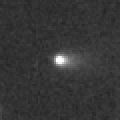
|
It is expected to brighten up to 12 mag in early summer. Now it is 15.2 mag (Feb. 16, ATLAS-HKO, Haleakala). Brightening gradually. It locates somewhat low in the Northern Hemisphere. In the Southern Hemisphere, it will be unobservable in April. At the high light, it is not observable in the Southern Hemisphere, or it locates low in the Northern Hemisphere.
Date(TT) R.A. (2000) Decl. Delta r Elong. m1 Best Time(A, h)
Feb. 24 2 10.35 -8 40.1 2.232 1.858 55 15.2 19:14 ( 57, 26)
Mar. 2 2 15.30 -4 52.5 2.236 1.780 50 15.0 19:20 ( 65, 24)
|

|
The condition is bad in this apparition. It brightens up to 10 mag in early summer, however, it is not observable at all. Brightening rapidly. It will never be observable after this.
Date(TT) R.A. (2000) Decl. Delta r Elong. m1 Best Time(A, h)
Feb. 24 23 39.01 -10 7.6 2.427 1.517 18 15.6 19:14 ( 80, -3)
Mar. 2 23 57.28 -7 52.3 2.385 1.460 16 15.1 19:20 ( 84, -5)
|

|
It brightened up to 12.1 mag in 2023 spring (May 20, Jose Guilherme de S. Aguiar). Now it is 15.0 mag (Feb. 13, Chris Wyatt). Fading slowly. In the Northern Hemisphere, it is not observable now. In the Southern Hemisphere, it stays observable in good condition.
Date(TT) R.A. (2000) Decl. Delta r Elong. m1 Best Time(A, h)
Feb. 24 4 2.37 -64 33.8 4.218 4.138 78 15.2 19:14 ( 9,-11)
Mar. 2 4 8.72 -62 5.9 4.263 4.181 78 15.3 19:20 ( 13,-10)
|
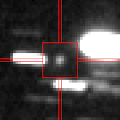
|
It is expected to brighten up to 12.5 mag in summer. Now it is 15.8 mag (Feb. 7, Thomas Lehmann). Brightening gradually. In the Northern Hemisphere, it is not observable now. In the Southern Hemisphere, it stays observable in good condition. Around the high light, it is observable in good condition in the Southern Hemisphere, but it locates very low in the Northern Hemisphere.
Date(TT) R.A. (2000) Decl. Delta r Elong. m1 Best Time(A, h)
Feb. 24 15 53.61 -68 35.3 3.674 3.699 83 15.5 5:12 (357,-14)
Mar. 2 16 6.02 -69 44.8 3.559 3.647 87 15.4 5:04 (358,-15)
|
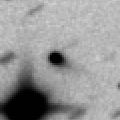
|
Now it is 14.7 mag (Feb. 12, Yukihiro Sugiyama). It will fade out rapidly after this. It will be fainter than 18 mag in May. In the Northern Hemisphere, it stays observable in good condition. It locates somewhat low in the Southern Hemisphere. But it will become high in spring.
Date(TT) R.A. (2000) Decl. Delta r Elong. m1 Best Time(A, h)
Feb. 24 7 30.65 37 27.1 0.791 1.629 132 15.4 21:17 (180, 88)
Mar. 2 7 37.13 36 23.8 0.823 1.625 126 15.5 20:56 (180, 89)
|
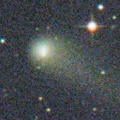
|
It brightened up to 11.1 mag in early 2022 (Mar. 31, 2022, F. Kugel, J.-G. Bosch, J. Nicolas). Now it is 15.3 mag (Feb. 9, Toshihiko Ikemura, Hirohisa Sato). It stays 16 mag for a while. In the Northern Hemisphere, it stays observable in good condition. It locates somewhat low in the Southern Hemisphere.
Date(TT) R.A. (2000) Decl. Delta r Elong. m1 Best Time(A, h)
Feb. 24 17 37.11 21 46.0 6.679 6.536 77 15.5 5:12 (286, 58)
Mar. 2 17 40.15 22 37.7 6.643 6.575 81 15.5 5:04 (288, 62)
|
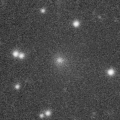
|
Now it is 15.7 mag (Feb. 16, Taras Prystavski). Fading gradually. It will be fainter than 18 mag in June. In the Northern Hemisphere, it will be getting higher gradually. In the Southern Hemisphere, it stays observable in good condition.
Date(TT) R.A. (2000) Decl. Delta r Elong. m1 Best Time(A, h)
Feb. 24 17 3.08 -43 43.2 1.405 1.517 76 15.5 5:12 (342, 8)
Mar. 2 17 5.96 -39 42.6 1.314 1.542 82 15.5 5:04 (344, 13)
|
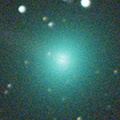
|
It approached to Earth down to 0.2 a.u. in early November, and brightened up to 6.2 mag (Nov. 11, Marco Goiato). Now it is 14.4 mag (Feb. 5, Thomas Lehmann). Fading gradually. It will be fainter than 18 mag in May. In the Northern Hemisphere, it will never be observable after this. It locates somewhat low in the Southern Hemisphere.
Date(TT) R.A. (2000) Decl. Delta r Elong. m1 Best Time(A, h)
Feb. 24 0 18.03 -43 59.7 2.736 2.106 41 15.7 19:14 ( 47,-16)
Mar. 2 0 27.60 -44 19.6 2.820 2.195 42 16.0 19:20 ( 49,-19)
|
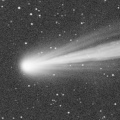
|
It approached to Sun down to 0.23 a.u. and brightened up to 2.5 mag in mid September (Sept. 18, Juan Jose Gonzalez). Now it is 17.0 mag (Feb. 13, ATLAS South Africa). Fading gradually. It will be fainter than 18 mag in May. It stays extremely low in the Northern Hemisphere. In the Southern Hemisphere, it stays observable in good condition. Thomas Lehmann reported it was bright as 14.1 mag on Feb. 4.
Date(TT) R.A. (2000) Decl. Delta r Elong. m1 Best Time(A, h)
Feb. 24 9 8.44 -53 31.8 2.457 3.006 114 15.7 22:51 ( 0, 2)
Mar. 2 8 50.91 -51 19.7 2.534 3.099 115 15.9 22:07 ( 0, 4)
|

|
Now it is 15.9 mag (Feb. 12, Hirohisa Sato). It stays 16 mag for a while. It will be getting lower gradually after this, and it will be unobservable in May in the Northern Hemisphere, or in June in the Southern Hemisphere.
Date(TT) R.A. (2000) Decl. Delta r Elong. m1 Best Time(A, h)
Feb. 24 4 29.92 -6 57.9 6.756 6.826 89 15.8 19:14 ( 21, 46)
Mar. 2 4 31.34 -6 14.5 6.827 6.797 84 15.8 19:20 ( 32, 44)
|

|
It will be observable at 15-16 mag from 2024 to 2025. Now it is 17.1 mag (Feb. 11, Toshihiko Ikemura, Hirohisa Sato). It stays 16 mag for a while. It stays observable in good condition.
Date(TT) R.A. (2000) Decl. Delta r Elong. m1 Best Time(A, h)
Feb. 24 13 18.05 2 12.0 2.863 3.645 136 15.9 3:06 ( 0, 57)
Mar. 2 13 16.06 2 32.2 2.782 3.629 143 15.8 2:37 ( 0, 57)
|
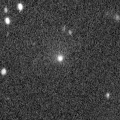
|
Very large comet. It is expected to brighten up to 13 mag in 2031. Now it is 15.8 mag (Feb. 8, Thomas Lehmann). It stays 16 mag for a while. In the Northern Hemisphere, it is not observable now. In the Southern Hemisphere, it stays observable in good condition. In the Northern Hemisphere, it is not observable until 2030.
Date(TT) R.A. (2000) Decl. Delta r Elong. m1 Best Time(A, h)
Feb. 24 2 55.17 -63 10.5 16.954 16.660 71 15.9 19:14 ( 17,-13)
Mar. 2 2 56.97 -62 52.8 16.936 16.636 70 15.9 19:20 ( 20,-15)
|
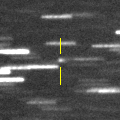
|
It is expected to brighten up to 15.5 mag from March to April. Now it is 16.8 mag (Feb. 12, ATLAS-HKO, Haleakala). Fading slowly. It locates somewhat low in the Northern Hemisphere. But it will become high in spring. In the Southern Hemisphere, it stays observable in good condition.
Date(TT) R.A. (2000) Decl. Delta r Elong. m1 Best Time(A, h)
Feb. 24 17 55.55 -14 16.8 1.640 1.532 65 16.2 5:12 (317, 29)
Mar. 2 18 17.16 -13 53.7 1.598 1.528 67 15.9 5:04 (316, 29)
|
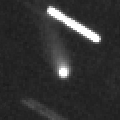
|
Now it is 16.4 mag (Feb. 5, ATLAS Chile). It stays 16 mag for a while. In the Northern Hemisphere, it will be unobservable in March. It locates somewhat low in the Southern Hemisphere. But it will become high in summer. The brightness evolution is slower than originally expected.
Date(TT) R.A. (2000) Decl. Delta r Elong. m1 Best Time(A, h)
Feb. 24 1 49.46 -30 44.5 3.655 3.138 51 16.0 19:14 ( 45, 7)
Mar. 2 1 53.82 -30 48.4 3.672 3.105 48 16.0 19:20 ( 49, 2)
|

|
Now it is 16.1 mag (Feb. 11, ATLAS-MLO, Mauna Loa). It will fade out rapidly after this. It will be fainter than 18 mag in April. In the Northern Hemisphere, it will be getting lower gradually. In the Southern Hemisphere, it will be unobservable in March.
Date(TT) R.A. (2000) Decl. Delta r Elong. m1 Best Time(A, h)
Feb. 24 1 58.09 18 44.1 2.148 1.856 59 16.3 19:14 ( 85, 41)
Mar. 2 2 9.87 21 33.5 2.233 1.876 56 16.5 19:20 ( 92, 38)
|
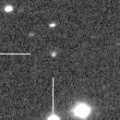
|
Now it is 16.4 mag (Feb. 11, Toshihiko Ikemura, Hirohisa Sato). It stays 16 mag for a while. It locates somewhat low in the Northern Hemisphere. But it will become high in summer. In the Southern Hemisphere, it stays observable in good condition.
Date(TT) R.A. (2000) Decl. Delta r Elong. m1 Best Time(A, h)
Feb. 24 14 10.63 -28 47.7 2.931 3.445 113 16.4 3:59 ( 0, 26)
Mar. 2 14 13.18 -28 49.5 2.848 3.447 119 16.3 3:34 ( 0, 26)
|
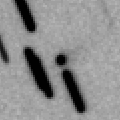
|
Now it is 15.8 mag (Feb. 13, Yukihiro Sugiyama). Fading gradually. It will be fainter than 18 mag in May. It stays observable in good condition.
Date(TT) R.A. (2000) Decl. Delta r Elong. m1 Best Time(A, h)
Feb. 24 8 41.02 -16 0.5 0.857 1.754 143 16.4 22:26 ( 0, 39)
Mar. 2 8 38.22 -16 29.4 0.873 1.749 139 16.5 21:55 ( 0, 38)
|
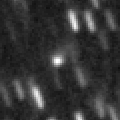
|
Now it is 17.4 mag (Feb. 14, ATLAS South Africa). It stays 16 mag for a while. It stays extremely low in the Northern Hemisphere. In the Southern Hemisphere, it stays observable in good condition.
Date(TT) R.A. (2000) Decl. Delta r Elong. m1 Best Time(A, h)
Feb. 24 16 53.23 -46 41.1 5.920 5.798 78 16.5 5:12 (345, 6)
Mar. 2 16 50.76 -47 26.0 5.778 5.775 84 16.4 5:04 (349, 6)
|

|
It brightened up to 13 mag in early 2023. It stays 17 mag for a while. It stays extremely low in the Northern Hemisphere. In the Southern Hemisphere, it stays observable in good condition.
Date(TT) R.A. (2000) Decl. Delta r Elong. m1 Best Time(A, h)
Feb. 24 16 35.93 -47 52.3 3.941 3.910 80 16.4 5:12 (348, 6)
Mar. 2 16 36.74 -47 46.1 3.893 3.969 87 16.4 5:04 (351, 6)
|
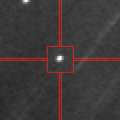
|
Now it is 17.5 mag (Feb. 16, ATLAS Chile). It stays 17 mag for a while. In the Northern Hemisphere, it is not observable now, but it will appear in March. In the Southern Hemisphere, it will be getting lower gradually after this, and it will be unobservable in June. But it will be observable again in March.
Date(TT) R.A. (2000) Decl. Delta r Elong. m1 Best Time(A, h)
Feb. 24 7 37.08 -80 41.7 1.833 2.039 87 16.9 21:11 ( 0,-25)
Mar. 2 6 20.35 -74 33.8 1.768 2.008 88 16.8 19:34 ( 0,-19)
|

|
Now it is 16.9 mag (Feb. 7, Toshihiko Ikemura, Hirohisa Sato). It stays 17 mag for a while. It will be unobservable in May.
Date(TT) R.A. (2000) Decl. Delta r Elong. m1 Best Time(A, h)
Feb. 24 4 39.18 28 31.7 4.748 4.977 97 16.8 19:14 ( 61, 78)
Mar. 2 4 42.20 27 59.1 4.843 4.964 91 16.9 19:20 ( 73, 72)
|
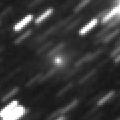
|
Very far object. Now it is 17.0 mag (Jan. 27, ATLAS Chile). It stays 17 mag for a while. In the Northern Hemisphere, it is not observable now.
Date(TT) R.A. (2000) Decl. Delta r Elong. m1 Best Time(A, h)
Feb. 24 2 12.48 -68 28.6 10.639 10.327 69 16.8 19:14 ( 17,-20)
Mar. 2 2 13.67 -67 43.3 10.640 10.329 69 16.8 19:20 ( 20,-21)
|
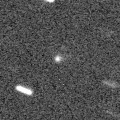
|
Now it is 17.0 mag (Feb. 9, Toshihiko Ikemura, Hirohisa Sato). Brightening slowly. It will be unobservable in May.
Date(TT) R.A. (2000) Decl. Delta r Elong. m1 Best Time(A, h)
Feb. 24 2 14.89 6 56.0 2.710 2.367 59 17.0 19:14 ( 69, 38)
Mar. 2 2 25.01 8 7.2 2.749 2.332 55 17.0 19:20 ( 75, 34)
|
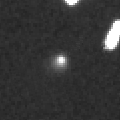
|
Now it is 16.9 mag (Feb. 17, ATLAS Chile). It stays 17 mag for a while. In the Northern Hemisphere, it will be unobservable in April. In the Southern Hemisphere, it stays observable in good condition.
Date(TT) R.A. (2000) Decl. Delta r Elong. m1 Best Time(A, h)
Feb. 24 4 47.20 -34 53.7 7.469 7.513 88 17.0 19:14 ( 9, 20)
Mar. 2 4 48.69 -34 1.2 7.507 7.491 85 17.0 19:20 ( 16, 19)
|

|
Now it is 16.5 mag (Jan. 31, Thomas Lehmann). It will fade out rapidly after this. It will be fainter than 18 mag in April. It locates somewhat low in the Northern Hemisphere. In the Southern Hemisphere, it will be unobservable in March.
Date(TT) R.A. (2000) Decl. Delta r Elong. m1 Best Time(A, h)
Feb. 24 1 25.08 12 32.4 2.714 2.210 49 17.0 19:14 ( 84, 31)
Mar. 2 1 39.73 13 46.6 2.789 2.228 46 17.2 19:20 ( 88, 28)
|

|
Now it is 17.0 mag (Feb. 13, ATLAS-HKO, Haleakala). It stays 17 mag for a while. It will be unobservable in April in the Southern Hemisphere, or in June in the Northern Hemisphere.
Date(TT) R.A. (2000) Decl. Delta r Elong. m1 Best Time(A, h)
Feb. 24 4 35.74 39 49.0 6.485 6.698 98 17.1 19:14 (119, 79)
Mar. 2 4 38.25 39 38.0 6.593 6.701 91 17.1 19:20 (112, 73)
|
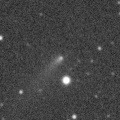
|
It brightened very rapidly up to 14.9 mag in early summer (July 13, Taras Prystavski). Now it is 17.2 mag (Jan. 16, Ken-ichi Kadota). Fading gradually. It will be fainter than 18 mag in April. In the Northern Hemisphere, it stays observable in good condition. It locates somewhat low in the Southern Hemisphere.
Date(TT) R.A. (2000) Decl. Delta r Elong. m1 Best Time(A, h)
Feb. 24 14 36.86 21 8.2 2.223 2.835 118 17.2 4:25 ( 0, 76)
Mar. 2 14 25.29 25 11.7 2.192 2.889 126 17.2 3:46 ( 0, 80)
|
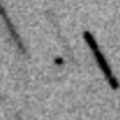
|
Now it is 17.5 mag (Feb. 12, Toshihiko Ikemura, Hirohisa Sato). It will brighten rapidly after this. It will be unobservable in April in the Northern Hemisphere, or in June in the Southern Hemisphere. It will brighten up to 11 mag in summer. But it is not observable at the high light.
Date(TT) R.A. (2000) Decl. Delta r Elong. m1 Best Time(A, h)
Feb. 24 2 28.09 -5 53.1 3.111 2.755 60 17.4 19:14 ( 55, 31)
Mar. 2 2 34.23 -5 7.7 3.108 2.671 55 17.2 19:20 ( 62, 27)
|

|
Now it is 17.1 mag (Feb. 12, Yukihiro Sugiyama). It stays 17 mag for a while. In the Northern Hemisphere, it will be getting lower gradually after this, and it will be unobservable in June. In the Southern Hemisphere, it stays observable in good condition.
Date(TT) R.A. (2000) Decl. Delta r Elong. m1 Best Time(A, h)
Feb. 24 7 46.38 -9 3.0 3.873 4.637 136 17.3 21:31 ( 0, 46)
Mar. 2 7 44.45 -8 44.8 3.892 4.599 130 17.3 21:02 ( 0, 46)
|
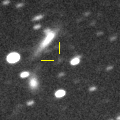
|
Now it is 17.1 mag (Feb. 7, Toshihiko Ikemura, Hirohisa Sato). It stays 17 mag for a while. It locates somewhat low in the Northern Hemisphere. In the Southern Hemisphere, it stays observable in good condition.
Date(TT) R.A. (2000) Decl. Delta r Elong. m1 Best Time(A, h)
Feb. 24 15 47.04 -28 40.5 2.955 3.174 93 17.4 5:12 (354, 26)
Mar. 2 15 52.26 -29 2.2 2.855 3.170 99 17.3 5:04 (358, 26)
|

|
Now it is 17.5 mag (Jan. 29, D. Buczynski). Fading slowly. It will be fainter than 18 mag in May. In the Northern Hemisphere, it stays observable in good condition. It locates somewhat low in the Southern Hemisphere.
Date(TT) R.A. (2000) Decl. Delta r Elong. m1 Best Time(A, h)
Feb. 24 6 45.92 20 41.6 1.715 2.434 126 17.3 20:32 ( 0, 76)
Mar. 2 6 47.80 21 21.9 1.779 2.426 119 17.4 20:06 ( 0, 76)
|
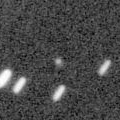
|
Now it is 17.2 mag (Feb. 9, Jean-Claude Merlin). It stays 17 mag for a while. It stays observable in good condition.
Date(TT) R.A. (2000) Decl. Delta r Elong. m1 Best Time(A, h)
Feb. 24 10 46.01 5 44.5 4.868 5.852 173 17.4 0:35 ( 0, 61)
Mar. 2 10 41.37 6 58.3 4.826 5.816 177 17.4 0:03 ( 0, 62)
|
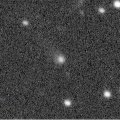
|
Now it is 17.6 mag (Feb. 5, ATLAS South Africa). It stays 18 mag for a while. In the Northern Hemisphere, it will never be observable after this. In the Southern Hemisphere, it stays observable in good condition.
Date(TT) R.A. (2000) Decl. Delta r Elong. m1 Best Time(A, h)
Feb. 24 4 50.93 -69 7.5 3.925 3.930 83 17.4 19:14 ( 4,-14)
Mar. 2 4 37.85 -67 42.8 3.965 3.951 81 17.5 19:20 ( 8,-14)
|
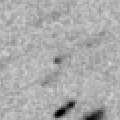
|
Now it is 18.3 mag (Feb. 12, Toshihiko Ikemura, Hirohisa Sato). It will fade out rapidly after this. It will be fainter than 18 mag in March. It stays observable in good condition.
Date(TT) R.A. (2000) Decl. Delta r Elong. m1 Best Time(A, h)
Feb. 24 12 12.12 1 41.7 1.235 2.161 152 17.5 2:01 ( 0, 57)
Mar. 2 12 8.02 1 25.4 1.212 2.171 160 17.6 1:29 ( 0, 56)
|
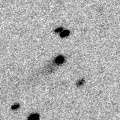
|
Now it is 17.3 mag (Feb. 3, ATLAS-MLO, Mauna Loa). It stays 18 mag for a while. It stays observable in good condition.
Date(TT) R.A. (2000) Decl. Delta r Elong. m1 Best Time(A, h)
Feb. 24 12 9.59 18 24.9 8.555 9.450 153 17.5 1:58 ( 0, 73)
Mar. 2 12 5.38 18 58.6 8.534 9.464 158 17.6 1:26 ( 0, 74)
|

|
Now it is 17.5 mag (Feb. 9, Jean-Claude Merlin). It stays 17 mag for a while. In the Northern Hemisphere, it is not observable now, but it will appear in March. In the Southern Hemisphere, it stays observable in good condition. It stays 15 mag for a long time from late 2024 to early 2026.
Date(TT) R.A. (2000) Decl. Delta r Elong. m1 Best Time(A, h)
Feb. 24 6 6.36 -57 18.7 5.405 5.574 94 17.6 19:51 ( 0, -2)
Mar. 2 6 3.58 -55 34.6 5.378 5.535 93 17.6 19:21 ( 0, 0)
|

|
Now it is 17.2 mag (Feb. 11, ATLAS South Africa). Fading gradually. It will be fainter than 18 mag in March. It locates somewhat low in the Northern Hemisphere. In the Southern Hemisphere, it stays observable in good condition.
Date(TT) R.A. (2000) Decl. Delta r Elong. m1 Best Time(A, h)
Feb. 24 8 11.37 -36 19.5 1.746 2.442 124 17.8 21:54 ( 0, 19)
Mar. 2 7 49.29 -35 55.0 1.845 2.484 119 17.9 21:05 ( 0, 19)
|
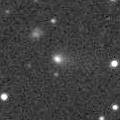
|
Now it is 17.2 mag (Feb. 11, ATLAS Chile). Fading slowly. It will be fainter than 18 mag in March. In the Northern Hemisphere, it will be getting lower gradually. It locates somewhat low in the Southern Hemisphere.
Date(TT) R.A. (2000) Decl. Delta r Elong. m1 Best Time(A, h)
Feb. 24 3 39.23 9 43.7 3.377 3.357 80 17.8 19:14 ( 51, 55)
Mar. 2 3 45.28 10 25.2 3.490 3.374 75 17.9 19:20 ( 60, 51)
|

|
It approached to Earth down to 0.29 a.u. in early last February, and it brightened up to 4.5 mag (Feb. 1, Juan Jose Gonzalez). Now it is 17.7 mag (Feb. 7, Thomas Lehmann). Fading slowly. It will be fainter than 18 mag in March. In the Northern Hemisphere, it will never be observable after this. In the Southern Hemisphere, it will be getting lower gradually.
Date(TT) R.A. (2000) Decl. Delta r Elong. m1 Best Time(A, h)
Feb. 24 3 0.33 -52 16.7 5.428 5.161 69 17.8 19:14 ( 22, -3)
Mar. 2 3 1.57 -51 16.3 5.529 5.228 67 17.9 19:20 ( 27, -5)
|
|
![]()
 C/2023 H5 ( Lemmon )
C/2023 H5 ( Lemmon ) C/2022 A3 ( Lemmon-ATLAS )
C/2022 A3 ( Lemmon-ATLAS ) 216P/LINEAR
216P/LINEAR C/2020 F2 ( ATLAS )
C/2020 F2 ( ATLAS ) C/2024 A1 ( ATLAS )
C/2024 A1 ( ATLAS ) C/2022 V2 ( Lemmon )
C/2022 V2 ( Lemmon ) 170P/Christensen
170P/Christensen C/2022 E3 ( ZTF )
C/2022 E3 ( ZTF )![]()


























































